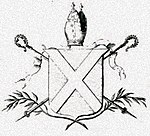|
John Spottiswoode
John Spottiswoode (Spottiswood, Spotiswood, Spotiswoode or Spotswood) (1565 – 26 November 1639) was an Archbishop of St Andrews, Primate of All Scotland, Lord Chancellor, and historian of Scotland.[1] LifeHe was born in 1565 at Greenbank in Mid Calder, West Lothian, Scotland, the eldest son of John Spottiswood, minister of Calder and superintendent of Lothian. He was educated at the University of Glasgow (MA 1581), and succeeded his father in the parish of Calder in 1583. In 1601 he attended Ludowick, Duke of Lennox, as his chaplain, in an embassy to the court of France, returning in 1603. He followed James VI and I to England on his accession at the Union of the Crowns.[1] He was sent back to Scotland to attend Anne of Denmark as her almoner or "elemosynar", receiving a yearly stipend of £80.[2] In the same year he was nominated to the Archbishop of Glasgow, his consecration in London, however, not taking place until October 1610.[1] Spottiswoode had originally become prominent as an ardent supporter of the strict Presbyterian party, but gradually came to see the inconveniences of "parity of ministers", attributed little importance to the existing matters of dispute, and thought that the interests of both church and state were best secured by keeping on good terms with the king. He was therefore ready to co-operate with James in curtailing the independent powers of the Kirk which encroached on the royal authority, and in assimilating the Church of Scotland into the Anglican Communion. On 30 May 1605 he became a member of the Scottish Privy Council.[1] In 1608 he worked closely with George Home, Earl of Dunbar in appointing suitable ministers to vacant parishes in the Borders as part of James' programme for bringing peace to the region.[3] In 1610 he presided as moderator over the assembly in which the supremacy of Presbyterianism was abolished. That same year he was consecrated bishop on 21 October by the bishops of London, Ely, Rochester, and Worcester. In 1614, he was instrumental in the arrest in Glasgow, trial, and execution at Glasgow Cross of Fr. John Ogilvie, an underground missionary priest of the strictly illegal Catholic Church in Scotland. In 1615 he was made Archbishop of St Andrews and Episcopalian Primate of Scotland, and in 1618 procured the sanction of the privy council to the Five Articles of Perth with their ratification by parliament in 1621.[1] In 1633 he crowned Charles I at Holyrood. In 1635 he was appointed Lord Chancellor of Scotland, an office which he retained until 1638.[1] John founded Dairsie Old Church, and re-built Dairsie Castle as a family home. The castle was rebuilt from a ruin in the 1990s, and his family crest is visible inside and outside the buildings. He was opposed to the new liturgy as inexpedient, but when he could not prevent its introduction he took part in enforcing it. He was a spectator of the riot of St Giles, Edinburgh, on 23 July 1637, endeavoured in vain to avoid disaster by concessions, and on the taking of the Covenant perceived that "now all that we have been doing these thirty years past is thrown down at once." He escaped to Newcastle, was deposed by the assembly on 4 December on a variety of ridiculous charges, and died in London on 26 November 1639, receiving burial in Westminster Abbey on 2 December 1639.[1] Spottiswoode published in 1620 Refutatio libelli de regimine ecclesiae scoticanae, an answer to a tract of David Calderwood, who replied in the Vindiciae subjoined to his Altare damascenum (1623). The only other writing published during his lifetime was the sermon he preached at the Perth assembly. His most considerable work was The History of the Church and State of Scotland (London, 1655, seq.). It displays considerable research and sagacity, and even when dealing with contemporary events gives a favorable impression, upon the whole, of the author's candour and truth. The opposite side can be studied in Calderwood's History of the Kirk of Scotland.[1] CriticismThe Secession historian Thomas M'Crie was very critical of Spottiswoode.[4] He said,
In a 2011 biography of Scottish Roman Catholic martyr Fr. Alexander Cameron, Monsignor Thomas Wynne, a priest of the Roman Catholic Diocese of Argyll and the Isles, was equally critical of Archbishop Spottiswoode, "Of all the priests who fell into the hands of the Scottish Government after the Reformation, John Ogilvie was the only one to be executed. There were two reasons for his execution: firstly, he was far too successful in his work as a priest; and, secondly, Archbishop Spottiswoode, to show his own loyalty in opposing the Papacy, for he was indeed suspect, used Ogilvie's capture and execution as proof of his orthodoxy to the Reformed faith and loyalty to the King. John Ogilvie was executed at Glasgow Cross on 28th February 1615, and his martyrdom has long been recognized by the Church. He was Canonized on 17th October, 1976."[5] FamilySpottiswoode married Rachel, daughter of David Lindsay, Bishop of Ross, with issue a daughter and two sons:[6]
Sources
See also
References
|
||||||||||||||||||||||||||||||
Portal di Ensiklopedia Dunia

